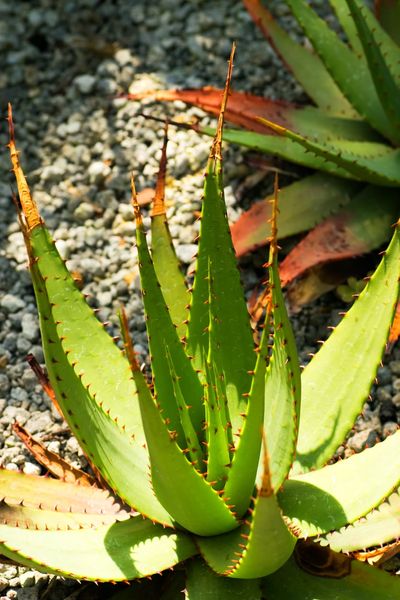Common Aloe Varieties
There are many common varieties of aloe and some that are rare or difficult to find. Most are native to various parts of Africa and nearby areas and, as such, are drought and heat tolerant. The aloe vera plant has been around and in use for centuries. It is mentioned in the Bible. Aloe vera and its derivatives have currently reached an all-time high for both internal and external use. So it is no surprise then that many gardeners are now exploring different types of aloe. Growing the following aloe vera relatives may be something you’d like to consider adding to your indoor or outdoor garden: •Sudan aloe (Aloe sinkatana) – The juice from this plant is used in much the same way as that of the aloe vera. This stemless, rosette shaped plant grows quickly and is one of the most valuable aloe vera relatives to landscapers, as it is said to flower often and produce long-lasting blooms. It readily offsets at the base. •Stone aloe (Aloe petricola) – This aloe grows to two feet (.61 m.) with impressive bi-colored blooms, making it twice as tall. Stone aloe is so named because it grows well and thrives in rocky areas. The plant blooms in mid-summer, just when fresh color is often needed in the landscape. Add several as a background in a rock garden or other partially sunny spot. Juices from Stone aloe are also used for burns and digestion. •Cape aloe (Aloe ferox) – This aloe vera relative is a source of bitter aloe, coming from a layer of the inner juices. Bitter aloe is an ingredient in laxatives, as it contains a powerful purgative. In the wild, this substance discourages predators. Aloe ferox also has a layer of juice similar to those in aloe vera and is used in cosmetics. Growing this variety provides a showy succulent in the landscape in zones 9-11. •Spiral aloe (Aloe polyphylla) – The Spiral aloe plant is one of the most attractive of the species, with perfect spirals of pointed leaves forming the plant. If you own one of these, take special care to keep it healthy. It is rare and classified as an endangered species. Flowers are showy and may appear in spring on well-established plants. Fan aloe (Aloe plicatilis) – So named because it has leaves in a unique and attractive fan shape, this aloe attracts birds and bees to the garden and is useful as a backdrop for other succulent plants. Aloe plicatilis is an endangered species and is protected from common uses. Stone aloe (Aloe petricola) – This aloe grows to two feet (.61 m.) with impressive bi-colored blooms, making it twice as tall. Stone aloe is so named because it grows well and thrives in rocky areas. The plant blooms in mid-summer, just when fresh color is often needed in the landscape. Add several as a background in a rock garden or other partially sunny spot. Juices from Stone aloe are also used for burns and digestion. Cape aloe (Aloe ferox) – This aloe vera relative is a source of bitter aloe, coming from a layer of the inner juices. Bitter aloe is an ingredient in laxatives, as it contains a powerful purgative. In the wild, this substance discourages predators. Aloe ferox also has a layer of juice similar to those in aloe vera and is used in cosmetics. Growing this variety provides a showy succulent in the landscape in zones 9-11. •Spiral aloe (Aloe polyphylla) – The Spiral aloe plant is one of the most attractive of the species, with perfect spirals of pointed leaves forming the plant. If you own one of these, take special care to keep it healthy. It is rare and classified as an endangered species. Flowers are showy and may appear in spring on well-established plants. Fan aloe (Aloe plicatilis) – So named because it has leaves in a unique and attractive fan shape, this aloe attracts birds and bees to the garden and is useful as a backdrop for other succulent plants. Aloe plicatilis is an endangered species and is protected from common uses. •Stone aloe (Aloe petricola) – This aloe grows to two feet (.61 m.) with impressive bi-colored blooms, making it twice as tall. Stone aloe is so named because it grows well and thrives in rocky areas. The plant blooms in mid-summer, just when fresh color is often needed in the landscape. Add several as a background in a rock garden or other partially sunny spot. Juices from Stone aloe are also used for burns and digestion. •Cape aloe (Aloe ferox) – This aloe vera relative is a source of bitter aloe, coming from a layer of the inner juices. Bitter aloe is an ingredient in laxatives, as it contains a powerful purgative. In the wild, this substance discourages predators. Aloe ferox also has a layer of juice similar to those in aloe vera and is used in cosmetics. Growing this variety provides a showy succulent in the landscape in zones 9-11. •Spiral aloe (Aloe polyphylla) – The Spiral aloe plant is one of the most attractive of the species, with perfect spirals of pointed leaves forming the plant. If you own one of these, take special care to keep it healthy. It is rare and classified as an endangered species. Flowers are showy and may appear in spring on well-established plants. Fan aloe (Aloe plicatilis) – So named because it has leaves in a unique and attractive fan shape, this aloe attracts birds and bees to the garden and is useful as a backdrop for other succulent plants. Aloe plicatilis is an endangered species and is protected from common uses.
